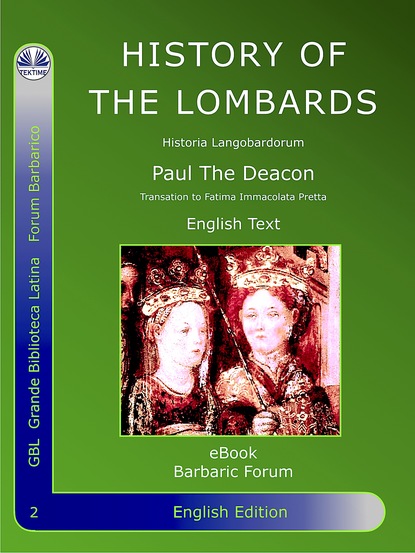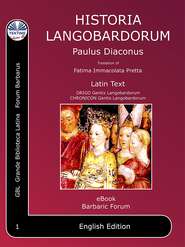По всем вопросам обращайтесь на: info@litportal.ru
(©) 2003-2024.
✖
History Of The Lombards
Настройки чтения
Размер шрифта
Высота строк
Поля
English
Barbaric Forum
1 - Historia Langobardorum - Paulus Diaconus - Latin (EN) - ISBN 9788835402640
2 - History of the Lombard Peoples - Paul The Deacon - English (EN) - ISBN in lavorazione
5 - Origo Gentis Langobardorum - Re Rotari - Latin (EN) - ISBN 9788827527665
Forum Latino
4 - On The Civil War - Gaio Julio Caesar - English text - ISBN
5 - On The Alexandrian War - Gaio Julius Caesar - English and Latin text - ISBN 9788835404064
6 - On The African War - Gaio Julius Caesar - English and Latin text - ISBN
7 . On The Spanish War - Gaio Julius Caesar . English and Latin text - ISBN
Français
1 - Historia Langobardorum - Paulus Diaconus - Latin (FR) - ISBN 978882287964
2 - …
5 - Origo Gentis Langobardorum - Re Rotari - Latin (FR) - ISBN 9788827531433
Deutsch
1 - Historia Langobardorum - Paulus Diaconus - Latin (DE) - ISBN 9788873041740
2 - Geschichte der Langobarden - Paul Warnefried - Deutsch - ISBN in lavorazione
5 - Origo Gentis Langobardorum - Re Rotari - Latin (DE) - ISBN 9788827534892
Português
1 - Historia Langobardorum - Paulus Diaconus - Latino (PR) - ISBN 9788873040224
2 - Historias dos Lombardos - Paolo Diacono - Português - ISBN 9788873043164
5 - Origo Gentis Langobardorum - Re Rotari - Latino (PR) - ISBN 9788827524541
中国 (Cinese)
1 - Historia Langobardorum - Paulus Diaconus - 拉丁 (CI) - ISBN in lavorazione
2 - 伦巴德人的故事-伦巴第史 (Storia dei Longobardi) - Paolo Diacono - 中国 - ISBN 9788873046462
5 - 伦巴第人的起源 (Origo Gentis Langobardorum) - Re Rotari - Latin (CI) - ISBN 9788828336730
LIBRI - BOOKS
1 - Historia Langobardorum - Paulus Diaconus - ISBN 9788822898722
2 - Storia dei Longobardi - Palo Diacono - ISBN 9788826053431
History of the Lombards
Historia Langobardorum
Paul The Deacon
Paulus Diaconus
English Text
English Edition
eBook
Barbaric Forum
Volume 2
GBL Grande Biblioteca Latina
www.grandebibliotecalatina.com
BOOK OPTIMIZED FOR THE BLIND PEOPLE
On the cover, a digital copy of a detail of the frescoes in the Teodolinda chapel in Monza, a small town a few kilometers from Milan.
PREFACE
EDITOR'S NOTE
If you know the text of Paolo Diacono you can omit to read this preface or you can read only the parts that interest you.
However, it is divided into short and clear thematic sections, useful for framing the text correctly.
History
Why publish an old and manifestly biased book in Latin? The reason is right there, in the definition of "part": written history is always part because it is generated by a "cultural structure"; entity that often coincides with the "nation-state". In practice for history, the same concept is valid for art, each era gives a different judgment on a given work of art. As a boy, when I studied art in high school, I went to the school library to consult a famous and beautiful series dedicated to painters, in those books the critical judgments of art experts and artists of different eras were reported. There you could see the change of opinion over time. So a Baroque work first pleases, then is despised and then returns to be found beautiful. This change of opinion is closely linked to historical events and social changes. To explain some basic concepts I will continue to use the art-history parallelism, which I believe is the most suitable. Here I briefly describe a personal experience I had at the University in taking a Medieval History exam. Attending the exams of some students of my age, I noticed their difficulty in defining historical periods, their attachment to dates. The teacher of the Statale di Milano was greatly irritated to see the inability to argue about the beginning and end dates of the Middle Ages. The dates are school conventions, the ancient age does not end a day in a certain place, but it is a border that shifts and brings with it social changes, often not uniform. The Gothic kingdom in Italy is perhaps already Middle Ages but we consider it late ancient, because we tend to start the Middle Ages in Italy with the twenty years of the Gothic wars or with the Lombard invasion in the peninsula. The right answer to the question `` when does the Middle Ages begin? '' Is the conventional date of the dismissal of the last Roman emperor of the West, accompanied by the clarification that it is, in reality, a long transition period going from Odoacre, to the Lombards, and does not involve the whole territory uniformly. If we look at art, we see the splendid mosaics of Ravenna, but then the imposing mausoleum of Theodoric appears, I point out that, after these, we move on to a paleo-Christian poor art: art marks well the passage from the ancient world to the new times. In the same way, regardless of the date on which Columbus was discovered to have discovered America, the art of the second quarter of Florence already showed the Renaissance, which appears briefly and immediately dissolves into Mannerism which will become Baroque already in the Michelangelo's dome of San Pietro . Thus the Municipalities become Lordships and politics reconnect the thread with classical antiquity which has in itself the symbols of power. A strange history of Classical art was born in democratic Athens to become an instrument of every imperial ambition. In any case, even art decrees the end of the Middle Ages, with the return to plasticity and Vasari's "stil novo". In practice it is Michelangelo's David and not Colombo, the right date to remember.
So, having clarified that it is the common sensitivity and not the dates that mark History, we add the concept of state education. Each state exalts the history that suits him to justify its existence, one could also add the geographic factor that is an integral part of it, but it would result in a discussion to Plato and too long. Squeezing, the Lombards divided Italy and for the future nation-state, everything that does not have Rome as its capital, and the entire national territory as a domain is negative, ugly, not important. This was the interest of the Savoys, of the Risorgimento patriots, of the kingdom and also of the Duce, now, with a party called the Northern League, the "trumpets of Rome" have returned to make themselves heard by dirtying the historical truth. I believe that Risorgimento Italy has become a mature state, ready to become Europe and part of the world. After all, for a hundred and fifty years, Savoiardi have been famous biscuits excellent for tiramisu and anti-Germanic sentiment has turned into sporting antagonism. Therefore, allowing everyone to read a text like this in its original format without state cultural mediation allows contemporary, "scientific" man to judge for himself and to deepen the topic at his leisure.
Author







